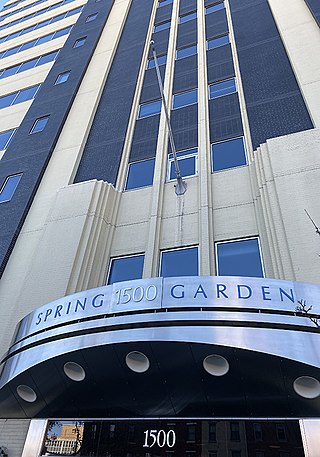Related Research Articles
The Institute for Scientific Information (ISI) was an academic publishing service, founded by Eugene Garfield in Philadelphia in 1956. ISI offered scientometric and bibliographic database services. Its specialty was citation indexing and analysis, a field pioneered by Garfield.

The Zoological Journal of the Linnean Society is a monthly peer-reviewed scientific journal covering zoology published by Oxford University Press on behalf of the Linnean Society. The editor-in-chief is Maarten Christenhusz. It was established in 1856 as the Journal of the Proceedings of the Linnean Society of London. Zoology and renamed Journal of the Linnean Society of London, Zoology in 1866. It obtained its current title in 1969.

The British Journal of Pharmacology is a biweekly peer-reviewed medical journal covering all aspects of experimental pharmacology. It is published for the British Pharmacological Society by Wiley-Blackwell. It was established in 1946 as the British Journal of Pharmacology and Chemotherapy, and originally published by the British Medical Association. The journal obtained its current title in 1968.

The Web of Science is a paid-access platform that provides access to multiple databases that provide reference and citation data from academic journals, conference proceedings, and other documents in various academic disciplines.

African Invertebrates is a peer-reviewed open access scientific journal that covers the taxonomy, systematics, biogeography, ecology, conservation, and palaeontology of Afrotropical invertebrates, whether terrestrial, freshwater, or marine. It is published by Pensoft Publishers on behalf of the KwaZulu-Natal Museum and the editor-in-chief is John M. Midgley.

The Journal of Natural Products is a monthly peer-reviewed scientific journal covering all aspects of research on the chemistry and/or biochemistry of naturally occurring compounds. It is co-published by the American Society of Pharmacognosy and the American Chemical Society. The editor-in-chief is Philip J. Proteau.

ZooBank is an open access website intended to be the official International Commission on Zoological Nomenclature (ICZN) registry of zoological nomenclature. Any nomenclatural acts published electronically need to be registered with ZooBank prior to publication to be "officially" recognized by the ICZN Code of Nomenclature. Acts published in physical publications are encouraged, but not required to be registered prior to their publication.
BIOSIS Previews is an English-language, bibliographic database service, with abstracts and citation indexing. It is part of Clarivate Analytics Web of Science suite. BIOSIS Previews indexes data from 1926 to the present.
The Journal of Comparative Neurology is a peer-reviewed scientific journal that focuses on neuroscience and related fields, but specifically does not deal with clinical aspects of them. It was established in 1891 and is published by Wiley-Liss. The editor-in-chief is Patrick R. Hof. From 1904 till 1910 the journal was named Journal of Comparative Neurology and Psychology.

Brain Structure and Function is a bimonthly peer-reviewed scientific journal covering research on brain structure-function relationships. It was established in 1891 as Anatomische Hefte, renamed first Zeitschrift für Anatomie und Entwicklungsgeschichte in 1921 and then Anatomy and Embryology in 1974, before obtaining its current name in 2007. It is published by Springer Science+Business Media and the editors-in-chief are Michel Thiebaut de Schotten and Susan R. Sesack.
The Journal of Zhejiang University Science B: Biomedicine & Biotechnology is a monthly peer-reviewed scientific journal covering biomedicine, biochemistry, and biotechnology. It was established in 2000 and is published by Zhejiang University Press in collaboration with Springer Science+Business Media. The editors-in-chief are Shu-min Duan and De-nian Ba, both of Zhejiang University.
Caldasia is a quarterly peer-reviewed open access scientific journal published by the Instituto de Ciencias Naturales since 1940. Articles are written in Spanish or English. The journal covers biodiversity topics in a wide sense, including the documentation, understanding, or conservation of biological diversity and thus accepts papers on botany, zoology, ecology, biodiversity, biogeography, taxonomy, systematics, conservation, anthropology, and related disciplines. It publishes full papers, reviews, or short communications. The journal charges no publication fees to authors.
Palaeontologia Electronica is a triannual peer-reviewed open-access scientific journal published by Coquina Press covering paleontology. It was established in 1998 and is the oldest fully open-access electronic journal of paleontology. The journal is sponsored by the Society of Vertebrate Paleontology, the Paleontological Society, the Palaeontological Association, and the Western Interior Paleontological Society. The editors-in-chief are Julien Louys and Andrew Bush. In 2000, the first taxonomic names published electronically under new rules in the International Code of Zoological Nomenclature were published in the journal by Scott et al. for three new species of fossil foraminifera: Eggerella matsunoi, Haplophragmoides hatai, and Haplophragmoides nishikizawensis.
Zoological Studies is a peer-reviewed open access scientific journal covering zoology, with focuses on animal behavior, comparative physiology, evolution, ecology, systematics and biogeography. It is published by the Biodiversity Research Center, Academia Sinica, Taiwan. The editor-in-chief is Benny K.K. Chan. It was established in 1962 as the Bulletin of the Institute of Zoology, Academia Sinica, receiving its current title in 1994.

Taxon is a bimonthly peer-reviewed scientific journal covering plant taxonomy. It is published by Wiley on behalf of the International Association for Plant Taxonomy, of which it is the official journal. It was established in 1952 and is the only place where nomenclature proposals and motions to amend the International Code of Nomenclature for algae, fungi, and plants can be published. The editor-in-chief is Dirk C. Albach.

Nomenclator Zoologicus is one of the major compendia in the field of zoological nomenclature, compiled by Sheffield Airey Neave and his successors and published in 9 volumes over the period 1939–1994, under the auspices of the Zoological Society of London; a tenth, electronic-only volume was also produced before the project ceased. It contains over 340,000 published name instances with their authorities and details of their original publication, certain nomenclatural notes and cross references, and an indication of the taxonomic group to which each is assigned. An electronic (digitised) version of volumes 1-10 was released online by the uBio project, based at the Marine Biological Laboratory, Woods Hole, in 2004–2005.
The Index to Organism Names (ION) is an extensive compendium of scientific names of taxa at all ranks in the field of zoology, compiled from the Zoological Record by its operators as a publicly accessible internet resource. Initially developed by BIOSIS, its ownership then passed to Thomson Reuters and is currently with Clarivate Analytics.
The Wells and Wellington affair was a dispute about the publication of three papers in the Australian Journal of Herpetology in 1983 and 1985. The periodical was established in 1981 as a peer-reviewed scientific journal focusing on the study of amphibians and reptiles (herpetology). Its first two issues were published under the editorship of Richard W. Wells, a first-year biology student at Australia's University of New England. Wells then ceased communicating with the journal's editorial board for two years before suddenly publishing three papers without peer review in the journal in 1983 and 1985. Coauthored by himself and high school teacher Cliff Ross Wellington, the papers reorganized the taxonomy of all of Australia's and New Zealand's amphibians and reptiles and proposed over 700 changes to the binomial nomenclature of the region's herpetofauna.

Clarivate Plc is a British-American publicly traded analytics company that operates a collection of subscription-based services, in the areas of bibliometrics and scientometrics; business / market intelligence, and competitive profiling for pharmacy and biotech, patents, and regulatory compliance; trademark protection, and domain and brand protection. In the academy and the scientific community, Clarivate is known for being the company that calculates the impact factor, using data from its Web of Science product family, that also includes services/applications such as Publons, EndNote, EndNote Click, and ScholarOne. Its other product families are Cortellis, DRG, CPA Global, Derwent, CompuMark, and Darts-ip, and also the various ProQuest products and services.
Conservation Letters is a bimonthly peer-reviewed open access scientific journal of the Society for Conservation Biology published by Wiley-Blackwell. It was established in 2008 and covers research on all aspects of conservation biology. The editor-in-chief is Graeme Cumming.
References
- ↑ "Zoological Record: Print Volume Number Information". Clarivate Analytics Support. Clarivate Analytics. Retrieved 21 August 2019.
2016 volume 152. 2016 was the last year that the print version of Zoological Record was made available.
- 1 2 3 Bridson, G. D. R. (1968). "The Zoological Record – A Centenary Appraisal". Journal of the Society for the Bibliography of Natural History. 5 (1): 23–34. doi:10.3366/jsbnh.1968.5.1.23.
- ↑ "Zoological Info Now Current". Information Today. 5 (3): 32. March 1988. ISSN 8755-6286.
- ↑ "News Briefs: BIOSIS and CSA Release Zoological Record Plus". Information Today. 18 (1): 23. 2001. ISSN 8755-6286.
- ↑ Chillingworth, Mark (February 2004). "Thomson captures Biosis in its life sciences web". Information World Review (199): 3. ISSN 0950-9879.
- ↑ "Zoological Record | Clarivate". clarivate.com. Retrieved 2024-12-28.
- ↑ The Record of Zoological Literature, 1865
- ↑ The Zoological Record, 1900
- ↑ "Genomics and taxonomy for all". Nature. 417 (6889): 573. 2002. Bibcode:2002Natur.417Q.573.. doi:10.1038/417573a. ISSN 0028-0836. PMID 12050616. S2CID 20975643.
- 1 2 3 Thorne, Joan (March 2003). "Zoological Record and the registration of new names in zoology". Bulletin of Zoological Nomenclature. 60 (1): 7–11. ISSN 0007-5167. Archived from the original on 2010-03-12.
- ↑ Patterson, David J.; Remsen, David; Norton, Cathy (December 2003). "Comment on Zoological Record and registration of new names in zoology". Bulletin of Zoological Nomenclature. 60 (4): 297–299. ISSN 0007-5167. Archived from the original on 2009-09-17. Retrieved 2009-12-09.
- ↑ Analytics, Clarivate. "ION: Index to Organism Names". www.organismnames.com. Retrieved 2024-12-28.
- ↑ Zoological record at Biodiversity Heritage Library.